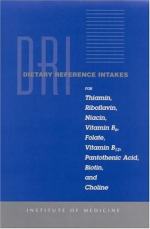|
This section contains 502 words (approx. 2 pages at 300 words per page) |

|
Derived from the Greek word pántothen, meaning from all quarters, pantothenic acid (C9H17NO5), generally referred to as vitamin B5, is an important factor in metabolic processes, particularly in the Krebs cycle. Historically, it has also been known as chick antidermatitis factor, Bios IIa, and the antigray-hair factor.
First discovered at the turn of the twentieth century and described as Bios, pantothenic acid was known to be essential for yeast growth. R.J. Williams and coworkers isolated crystalline Bios from yeast and named it pantothenic acid in 1933. A few years later, in 1938, Williams isolated the same substance from liver. By 1939, pantothenic acid was determined to be chemically identical to the antidermatitis factor found in chicks. Beta-alanine played an important role in pantothenic acid production, and in 1940, a method to synthesize and crystallize pantothenic acid was established. In 1950, acety l coenzyme A, a derivative...
|
This section contains 502 words (approx. 2 pages at 300 words per page) |

|


